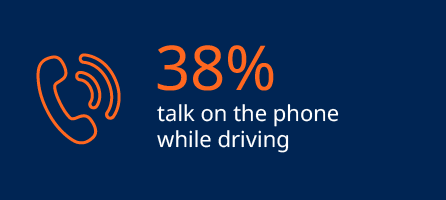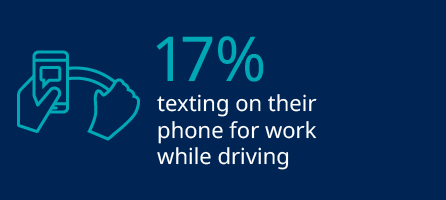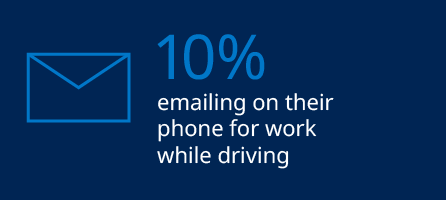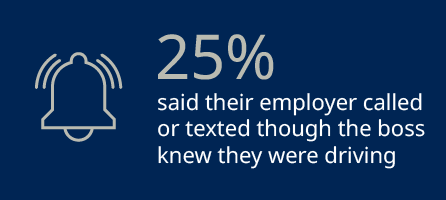All companies with commercial vehicles on the road need to come to grips with the Federal Motor Carrier Safety Administration (FMCSA)* regulations in relation to commercial distracted driving. The first step for any health and safety manager is to identify the most common distractions in the commercial distracted driving environment because these are what FMCSA health and safety officers will rightly pull them up on every time.
Understanding these hazards is the first sure-fire way to developing effective measures to eradicate commercial distracted driving and all its associated risks. Only when a health and safety manager fully grasps the most pressing causes of distracted driving can they begin to truly solve it.
Below are the top 5 distractions that health and safety managers should be concerned about in the commercial driving environment:
1.) Avoid the Clear Hazards of Using a Hand-Held Phone
“Do Not Text While Driving”
FMCSA regulations prohibit texting and hand-held mobile phone usage while operating a commercial vehicle, with a special focus on text messaging while driving. An employee will lose their commercial driver’s license on the spot if caught texting when driving. The whys are obvious: Research shows that commercial motor vehicle drivers who text are 23 times more likely to be involved in a safety-critical event than those who do not. It is a company’s responsibility and legal obligation to have a coherent, unequivocal and enforced policy against texting when driving. In the context of commercial driving, the hands-free device is no longer a tool but one of the most hazardous materials to be found inside or outside the commercial vehicle for its role in directly causing distraction and accidents.
But old habits die hard, which is why new tools allowing administrators control of employee mobile devices couldn’t come sooner. Fleet managers and company health and safety administrators can protect their drivers’ licenses by eliminating access to texts, hand-held calls and unsafe apps while allowing job-critical apps though their safety system.
2.) Dispatch Devices are Essential but Dangerous
“Do Not Use A Dispatch Device While Driving”
Drivers of commercial vehicles depend on other hands-free devices such as portable dispatch devices to communicate, keep logs or assist with navigation. Vital to a driver’s mission, the concentration-demanding dispatch device is also potentially one of the most hazardous materials at their disposal. Most commercial drivers face tight deadlines. The temptation, then, might be to read a message that pops up on the screen of a dispatch device or to crank up the engine before they’ve completed inputting data into the device, thus requiring them to complete the task while simultaneously operating their commercial vehicle. If they do this routinely, it becomes automatic, a habit that is hard to break, and one that significantly increases the risk of crashes. According to a 2009 study, drivers who use a dispatching device while driving are nine times more likely to be involved in an accident or other kinds of safety-critical incidents.
Yet, there are solutions to taking the risk out of using dispatch devices (the so-called “texting of truckers”). A company’s fleet management system can disable the use of dispatch devices while driving, connecting drivers and administrators in a safer and more efficient manner. Better dispatching devices are being built so that they are easier to use, allowing drivers to respond to messages without looking at the screen. Overall, the comprehensive management of a dispatch system can successfully combat distraction, leading to a safer fleet, less crashes on the road and, naturally, a happy health and safety manager.
3.) The Real Risks of Exhaustion
“Beware of Drowsiness”
FMCSA regulations related to the driving of commercial vehicles insists that no driver shall operate a commercial motor vehicle, and a motor carrier shall not require or permit a driver to operate a commercial vehicle, while the driver’s ability or alertness is impaired through fatigue.
Exhaustion, then, is a critical cause of driver distraction and health and safety managers are obliged to ensure their drivers are healthy and well-rested. How do they achieve this?
- Insisting drivers keep to hours-of-services regulations
- Instructing drivers to respect the indicators of fatigue (yawning, blurred vision, heavy eyes)
- Encouraging adequate sleep, healthy diet, napping and the non-usage of drowsy-inducing medication
- Providing electronic devices and solutions to monitor driver performance and offering a systematic collaborative approach to combating fatigue
4.) Avoid the Temptation to Eat and Drink While Driving
“Avoid Eating and Drinking When Driving”
All drivers who have completed their training to get their commercial drivers’ license know that fueling behind the wheel is risky, but with looming deadlines and long days of driving, commercial drivers might sometimes feel like driving is the only time they have to eat or drink.
Studies have found that eating while driving is an even riskier distraction than talking on a cell phone. Makes perfect sense: Eating while driving can take one’s eyes off the road and always takes at least one hand off the steering wheel.
The job of fleet managers and health and safety administrators within a company is to ensure their drivers are compliant with state and federal health and safety regulations, by requiring and incentivizing their drivers to always leave time to pull over and eat.
Health and Safety Managers can go a step further by implementing safety administration systems to monitor, score and rank driving performance. The use of dashboard technology can play a key role in ensuring drivers avoid the hazardous behavior of eating and drinking behind the wheel.
5.) External Distractions are Real
“Don’t Allow External Objects Distract You from Driving”
Drivers risk getting distracted by external objects outside their commercial vehicle such as billboards, buildings or people. Experienced holders of a commercial driver’s license know only too well how these objects can draw a driver’s eyes, hands and mind away from driving safely. Staying focused on the road ahead and paying attention only to tasks related to operating a commercial vehicle will keep drivers alert to the single vehicles around them, and make them ready to react to anything unexpected. It will also keep them and their company free from penalties, citations, and the prospect of losing to their commercial driver’s license.
Companies can ensure their drivers remain focused on driving by enforcing company policy against distracted driving and developing reports and portfolios on their drivers, while analyzing data on driving behavior and device usage.
The Final Word on Commercial Distracted Driving
Health and Safety managers need to be aware of these five hazardous distractions in a commercial driving environment. Reducing distractions that are detrimental to commercial truck driving is a critical component of improving the safety performance of commercial vehicle drivers, and makes the roads and highways safer for all drivers. By enforcing safety systems to effectively overcome these hazards, health and safety managers will make a critical contribution to the reduction of accident rates and the lowering of their company’s insurance costs.
Leading Causes of Employee Distracted Driving*





